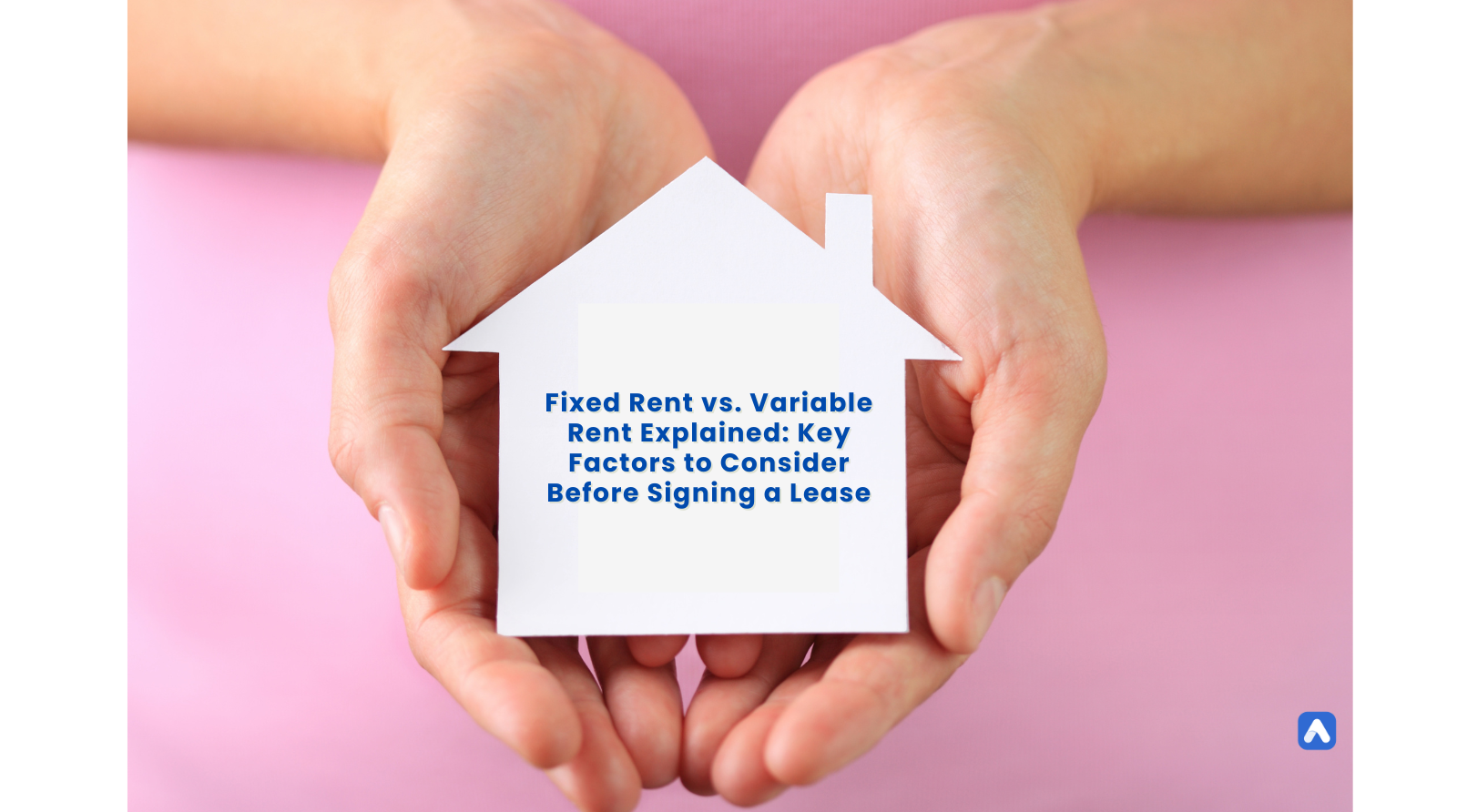Fixed Rent vs. Variable Rent Explained: Key Factors to Consider Before Signing a Lease
Introduction to Fixed Rent and Variable Rent
Definition and Basic Concepts
- Fixed Rent: A fixed rental amount that remains constant throughout the lease term, regardless of market fluctuations or changes in the tenant’s business.
- Variable Rent: A rental amount that can change over time based on predetermined factors, such as market conditions, the tenant’s performance, or specific agreed-upon criteria.
Key Differences Between Fixed and Variable Rent Structures
| Feature | Fixed Rent | Variable Rent |
|---|---|---|
| Payment Amount | Remains constant | Can fluctuate |
| Basis for Calculation | Predetermined amount | Agreed-upon factors (e.g., market rates, sales performance) |
| Risk | Primarily borne by the landlord | Shared between landlord and tenant |
| Flexibility | Limited | Higher |
Understanding Fixed Rent
What Is Fixed Rent? How It Works
- Fixed rental amount: A predetermined amount agreed upon by the landlord and tenant at the start of the lease.
- No adjustments: The rent remains unchanged for the entire lease term, providing stability and predictability for both parties.
Common Scenarios Where Fixed Rent Is Used
- Residential leases: The most common type of lease for residential properties.
- Long-term commercial leases: Suitable for tenants with stable businesses and a desire for predictable rental costs.
Advantages of Fixed Rent
- Stability: Tenants can budget more accurately, knowing their housing costs will remain constant.
- Predictability: Landlords have a guaranteed income stream, reducing financial uncertainty.
- Simplicity: The lease structure is straightforward and easy to understand.
Understanding Variable Rent
What Is Variable Rent? How It Works
- Base rent: A minimum rental amount agreed upon at the start of the lease.
- Variable component: An additional amount that can fluctuate based on predetermined factors.
- Calculation: The total rent is the sum of the base rent and the variable component.
Common Scenarios Where Variable Rent Is Used
- Retail leases: Percentage leases are common, where rent is tied to the tenant’s sales performance.
- Flexible workspace leases: Rent can fluctuate based on the tenant’s usage or occupancy.
- Industrial leases: Rent may be adjusted based on factors like energy consumption or production levels.
Advantages of Variable Rent
- Flexibility: Tenants can potentially benefit from lower rent during economic downturns or periods of decreased business activity.
- Revenue sharing: Landlords can share in the tenant’s success, potentially earning higher income during prosperous times.
- Market responsiveness: Variable rent can be more responsive to market changes, allowing for adjustments to rent levels.
Pros and Cons of Fixed Rent
Benefits for Tenants
- Budgeting: Fixed rent makes financial planning easier.
- Stability: Tenants can avoid the stress of fluctuating costs.
- Predictability: Tenants can accurately forecast their housing expenses.
Risks for Tenants
- Overpayment: If market rents decline, tenants may be paying above market rate.
- Lack of flexibility: Tenants may be unable to negotiate rent reductions during difficult times.
Benefits for Landlords
- Stable income: Landlords have a guaranteed income stream.
- Reduced risk: Landlords are protected from potential losses due to market fluctuations.
- Simplicity: Managing fixed rent leases is generally less complex than variable rent leases.
Risks for Landlords
- Lost income: If market rents rise, landlords may miss out on potential additional revenue.
- Reduced flexibility: Landlords may have limited ability to increase rents to match market conditions.
Pros and Cons of Variable Rent
Benefits for Tenants
- Potential savings: Tenants may benefit from lower rent during economic downturns.
- Flexibility: Tenants can potentially negotiate rent reductions or adjustments based on business performance.
- Market responsiveness: Tenants may pay a more fair rent that reflects current market conditions.
Risks for Tenants
- Fluctuating costs: Rent can be unpredictable, making budgeting difficult.
- Uncertainty: Tenants may face uncertainty about their future rental expenses.
- Overpayment: If market rents decline, tenants may still be required to pay a higher rent.
Benefits for Landlords
- Higher income: Landlords can capture higher income in a rising market.
- Flexibility: Landlords can adjust rents to match market conditions or the tenant’s performance.
- Shared risk: Landlords can share some of the risk associated with market fluctuations with the tenant.
Risks for Landlords
- Lower rent: Landlords may earn less during weak markets or off-seasons.
- Complexity: Managing variable rent leases can be more complex than fixed rent leases.
- Tenant default: If the tenant’s business performance declines, the landlord may face a higher risk of non-payment.
Variable Rent Structures: How They Are Calculated
Percentage Leases
- Rent based on sales: The rental amount is a percentage of the tenant’s gross sales.
- Common in retail: Widely used in retail leases, as it aligns the landlord’s income with the tenant’s success.
- Calculation: Rent = Base rent + (Sales percentage * Gross sales)
Market-Adjusted Leases
- Linked to market conditions: The rental amount is adjusted periodically based on market rent rates for similar properties.
- Regular reviews: The lease specifies the frequency of market rent reviews and the method for determining the new rental amount.
- Calculation: Rent = Base rent + (Market rent adjustment)
CPI-Linked Leases
- Tied to inflation: The rental amount is adjusted based on changes in the Consumer Price Index (CPI) or other economic indicators.
- Regular adjustments: The lease specifies the frequency of CPI adjustments and the formula for calculating the new rental amount.
- Calculation: Rent = Base rent + (CPI adjustment)
Financial Planning and Budgeting for Fixed vs. Variable Rent
How to Budget for Fixed Rent
- Stable monthly costs: Fixed rent provides predictable monthly expenses.
- Budgeting tools: Use budgeting software or spreadsheets to track rental payments and other expenses.
Challenges of Budgeting for Variable Rent
- Fluctuating costs: Variable rent can be unpredictable, making budgeting difficult.
- Contingency funds: Consider setting aside a contingency fund to cover potential rent increases.
Tools and Strategies for Managing Variable Rent Uncertainty
- Forecasting tools: Use forecasting tools to estimate future rent payments based on historical data and market trends.
- Risk management strategies: Consider hedging strategies or insurance to mitigate the risk of fluctuating rent payments.
Lease Negotiation: Choosing Between Fixed and Variable Rent
Factors to Consider When Negotiating a Fixed Rent Lease
- Market stability: If the market is stable, a fixed rent might be preferable.
- Tenant’s business: A tenant with a predictable income stream might be comfortable with a fixed rent.
- Risk tolerance: Both tenants and landlords need to assess their risk tolerance and decide if the potential benefits of variable rent outweigh the risks.
When a Variable Rent Agreement Makes Sense for Tenants and Landlords
- Unstable market: If the market is volatile, a variable rent can offer more flexibility.
- Tenant’s business: A tenant with a more variable business model might prefer a variable rent.
- Shared risk: Both tenants and landlords can share some of the risk associated with market fluctuations.
Balancing Risk and Flexibility in Lease Negotiations
- Negotiate terms: Negotiate the terms of the variable rent agreement, such as the factors that determine the rental amount and the frequency of adjustments.
- Consider hybrid options: Explore hybrid options that combine elements of fixed and variable rent.
Legal and Contractual Implications of Fixed and Variable Rent
Key Clauses to Look for in Fixed Rent Agreements
- Rental amount: Clearly specify the rental amount and any provisions for early termination or rent increases.
- Payment terms: Outline the payment frequency and due dates.
- Security deposit: Specify the amount of the security deposit and the conditions for its return.
Special Considerations for Variable Rent Leases
- Reporting requirements: Specify the requirements for reporting revenue or other relevant data.
- Market rent recalculations: Outline the method for determining market rent adjustments.
- Dispute resolution: Include provisions for resolving disputes related to rent calculations or adjustments.
Ensuring Transparency and Fairness in Variable Rent Contracts
- Clear language: Use clear and concise language to avoid misunderstandings.
- Fair terms: Ensure that the terms of the variable rent agreement are fair to both parties.
- Legal advice: Seek legal advice to ensure that the lease complies with applicable laws and regulations.
Case Studies: Examples of Fixed and Variable Rent in Practice
Residential Leasing
- Commonly fixed: Fixed rent is the most common type of lease for residential properties.
- Stability: Provides stability and predictability for both tenants and landlords.
- Exceptions: Variable rent may be used in specific situations, such as rent-to-own agreements or student housing.
Commercial Retail Leasing
- Percentage leases: Widely used in retail leasing, as they align the landlord’s income with the tenant’s success.
- Example: A tenant pays a base rent plus a percentage of their gross sales.
- Flexibility: Offers flexibility for both tenants and landlords, as rent is tied to the tenant’s performance.
Flexible Workspace Leases
- Hybrid models: Often incorporate elements of both fixed and variable rent.
- Example: A tenant pays a base rent plus a variable component based on their usage or occupancy.
- Flexibility: Allows tenants to pay for only the space and services they actually use.
Market Trends: Fixed vs. Variable Rent in Changing Economic Conditions
How Fixed and Variable Rent Respond to Economic Fluctuations
- Fixed rent: Remains constant regardless of economic conditions.
- Variable rent: Can be more responsive to economic fluctuations, allowing for adjustments to rent levels.
The Growing Popularity of Variable Rent in Uncertain Markets
- Flexibility: Variable rent offers more flexibility in uncertain markets.
- Risk sharing: Allows tenants and landlords to share some of the risk associated with market fluctuations.
Shifts in Leasing Practices: The Future of Rent Structures
- Hybrid models: Hybrid rent structures are becoming more common, combining elements of fixed and variable rent.
- Technology: Technology is enabling new types of rent structures, such as rent-to-own agreements or subscription-based models.
Conclusion: Deciding Between Fixed and Variable Rent
Summary of Fixed Rent vs. Variable Rent
The choice between fixed rent and variable rent is a critical decision for both tenants and landlords, as each structure offers distinct advantages and risks depending on the circumstances.
Common Scenarios
- Fixed Rent : Most commonly used in residential leases and long-term commercial leases where stability and predictability are preferred.
- Variable Rent : Often used in retail leases (e.g., percentage leases tied to sales), flexible workspace leases , and industrial leases where rent may be adjusted based on usage or performance.
Key Structures of Variable Rent
- Percentage Leases : Common in retail, where rent is a base amount plus a percentage of the tenant’s gross sales.
- Market-Adjusted Leases : Rent is periodically adjusted based on market conditions for similar properties.
- CPI-Linked Leases : Rent is adjusted based on changes in the Consumer Price Index (CPI) or other economic indicators.
Financial Planning and Budgeting
- Fixed Rent : Easier to budget due to its predictability. Tenants can use budgeting tools to manage their expenses effectively.
- Variable Rent : More challenging to budget due to potential fluctuations. Tenants may need contingency funds or forecasting tools to manage uncertainty.
Lease Negotiation Considerations
- Fixed Rent : Ideal in stable markets or for tenants with predictable income streams. Both parties need to assess their risk tolerance.
- Variable Rent : Suitable in volatile markets or for tenants with variable business models. Hybrid options that combine fixed and variable rent elements can offer a balanced approach.
Legal and Contractual Implications
- Fixed Rent Agreements : Key clauses include the rental amount, payment terms, and security deposit conditions.
- Variable Rent Agreements : Require clear language around reporting requirements, market rent recalculations, and dispute resolution mechanisms to ensure transparency and fairness.
Market Trends
- Economic Fluctuations : Fixed rent remains constant, while variable rent can adjust to economic changes, offering more flexibility in uncertain markets.
- Growing Popularity of Variable Rent : As markets become more volatile, variable rent structures are gaining popularity due to their flexibility and risk-sharing benefits.
- Hybrid Models : Combining elements of fixed and variable rent, hybrid models are becoming more common, especially with the rise of technology enabling new lease structures like rent-to-own agreements or subscription-based models.
The decision between fixed and variable rent depends on the specific needs and risk tolerance of both tenants and landlords. Fixed rent offers stability and predictability, making it ideal for long-term planning, while variable rent provides flexibility and responsiveness to market conditions, which can be advantageous in uncertain or fluctuating markets. Understanding the pros and cons of each structure, along with the legal and financial implications, is essential for making an informed leasing decision.






